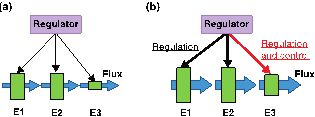Metabolic flux analysis
By linking metabolites and enzymes to higher-level biological functions, in vivo fluxes through metabolic networks are the integrated functional output of metabolism that determines the cellular phenotype. Thus, fluxes are key data i) to assess network behavior experimentally and ii) to verify predictions of metabolic models.
Jointly with the Zamboni lab, for about 15 years we have been a key player in developing 13C-based methods for both high resolution and high throughput flux analysis. Nearly all projects apply some aspects of flux measurements. Current technological developments focus on conceptually expanding these methods to dynamic transitions, complex nutritional situations, intracellular pathogens and fluxes between microbes in consortia such as the gut.

References
- Chubukov V, Uhr M, Le Chat L, Kleijn R, Jules M, Link H, Aymerich S, Stelling J & Sauer U (2013). Transcriptional regulation is insufficient to explain substrate-induced flux changes in B. subtilis. Mol Sys Biol. 9: 709.
- Hörl M, Schnidder J, Sauer U & Zamboni N. (2013) Non-stationary 13C-metabolic flux ratio analysis. Biotechnol Bioeng. 110:3164-76. external pagePubmedcall_made
- Rühl M, LeCoq D, Aymerich S & U Sauer. (2012) 13C-flux analysis reveals NADPH-balancing transhydrogenation cycles in stationary phase of nitrogen-starving B. subtilis. J Biol Chem. 287:27959-70 external pagePubmedcall_made
- Haverkorn BRB, Nanchen A, Nallet S, Kleijn RJ & Sauer U (2011). Large-scale 13C-flux analysis reveals distinct transcriptional control of respiratory and fermentative metabolism in E. coli. Mol Sys Biol. 7: 477
- Zamboni N, Fendt SM, Rühl M, Sauer U. (2009) 13C-based metabolic flux analysis. Nat Protocols 4:878-92. external pagePubmedcall_made
